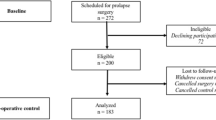Abstract
In a retrospective study investigating the relationship between levator avulsion and clinical grading of levator ani muscle strength, we analyzed the 3D/4D translabial ultrasound and digital assessment data of 1,112 women seen in a tertiary Urogynecological clinic. Levator avulsion was diagnosed whenever the examiner was unable to palpate the insertion of the pubovisceral muscle on the inferior pubic ramus and/or whenever a discontinuity between bone and muscle was detected on ultrasound. For clinical grading of levator muscle strength, we used the modified Oxford grading. Avulsion defects were found in 252 women (23%), and this was associated with a highly significant reduction in the overall Oxford grading (2.07 vs 2.81, P < 0.001). The prevalence of avulsion increased depending on the side differences in the modified Oxford grading: from 16% when there was no difference to 76% when the side difference was 1.5 or higher (P < 0.001). Avulsion of the puborectalis muscle seems to have a marked effect on pelvic floor muscle strength, which may help in diagnosing trauma.



Similar content being viewed by others
References
DeLancey J (2005) The hidden epidemic of pelvic floor dysfunction: achievable goals for improved prevention and treatment. Am J Obstet Gynecol 192:1488–1495
Dietz HP, Lanzarone V (2005) Levator trauma after vaginal delivery. Obstet Gynecol 106:707–712
Kearney R, Miller J, Ashton-Miller J, Delancey J (2006) Obstetric factors associated with levator ani muscle injury after vaginal birth. Obstet Gynecol 107(1):144–149
Dietz HP, Steensma AB (2006) The prevalence of major abnormalities of the levator ani in urogynaecological patients. BJOG 113(2):225–230
Dietz HP (2007) Quantification of major morphological abnormalities of the levator ani. Ultrasound Obstet Gynecol 29:329–334
Otcenasek M, Krofta L, Baca V et al (2007) Bilateral avulsion of the puborectal muscle: magnetic resonance imaging-based three-dimensional reconstruction and comparison with a model of a healthy nulliparous woman. Ultrasound Obstet Gynecol 29:692–696
Laycock J (1994) Clinical evaluation of the pelvic floor. In: Schuessler B (ed) Pelvic floor re-education: principles and practice. Springer, London, pp 42–48
Messelink B, Benson T, Berghmans B et al (2005) Standardization of terminology of pelvic floor muscle function and dysfunction: report from the Pelvic Floor Clinical Assessment Group of the International Continence Society. Neurourol Urodyn 24:374–380
Dietz HP (2007) Levator trauma and female pelvic organ prolapse. Int Urogynecol J 18(S1):S242
Kearney R, Miller JM, Delancey JO (2006) Interrater reliability and physical examination of the pubovisceral portion of the levator ani muscle, validity comparisons using MR imaging. Neurourol Urodyn 25(1):50–54
Dietz HP, Hyland G, Hay-Smith J (2006) The assessment of levator trauma: a comparison between palpation and 4D pelvic floor ultrasound. Neurourol Urodyn 25(5):424–427
Dietz H, Shek K (2007) Repeatability of digital palpation for the detection of levator trauma. Int Urogynecol J 18(S1):S156
DeLancey J, Morgan D, Fenner D et al (2007) Comparison of levator ani muscle defects and function in women with and without pelvic organ prolapse. Obstet Gynecol 109(2):295–302
Azpiroz F, Fernandez-Fraga X, Merletti R, Enck P (2005) The puborectalis muscle. Neurogastroenterol Motil 17(S1):68–72
Rosenbaum T (2007) Pelvic floor involvement in male and female sexual dysfunction and the role of pelvic floor rehabilitation in treatment: a literature review. J Sex Med 4(1):4–13
Acknowledgements
This study was supported in part by the Betty Byrne Henderson Foundation, University of Queensland, Brisbane, Queensland, Australia.
Author information
Authors and Affiliations
Corresponding author
Rights and permissions
About this article
Cite this article
Dietz, H.P., Shek, C. Levator avulsion and grading of pelvic floor muscle strength. Int Urogynecol J 19, 633–636 (2008). https://doi.org/10.1007/s00192-007-0491-9
Received:
Accepted:
Published:
Issue Date:
DOI: https://doi.org/10.1007/s00192-007-0491-9




